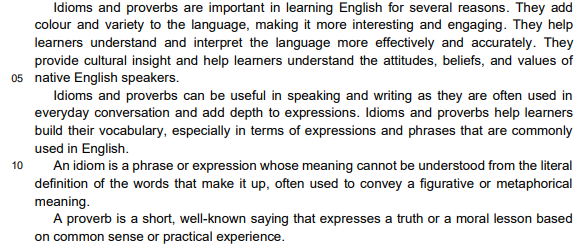Questões de Concurso Comentadas sobre inglês para professor - inglês
Foram encontradas 1.673 questões
Resolva questões gratuitamente!
Junte-se a mais de 4 milhões de concurseiros!
Fonte: https://english.elpais.com/spain/2021-10-05/how-lava-from-the-la-palma-volcano-turned-a-beloved-beach-into-the-newest-territory-on-earth.html
É possível afirmar que o trecho “The platform that has been formed by the molten rock off the coast of the Spanish Canary Island”:
Read:
From the social standpoint, integrating education to the realm of technology would allow students to:
Leia o texto para responder às questões de números 47 a 50.
We commonly observe in second language learners a plethora of errors attributable to the negative transfer of the native language to the target language. There can be interlingual interference at the phonological, syntactic, lexical, and semantic levels of language. For example, one might find a beginner learner who says “I am in New York since January”. Examples of distinctions at the lexical level may be seen in false cognates.
The early stages of second language learning are characterized by a predominance of interference (interlingual transfer), but once learners have begun to acquire parts of the new system, more and more intralingual transfer – generalization within the target language – is manifested. Negative intralingual transfer or overgeneralization is seen in such utterances as “Does John can sing?” or “He goed”.
A number of different categories for description of errors have been identified in research on learner language, among them:
I. The most generalized errors of addition, omission, substitution, and ordering. In English, for example, a definite article can be omitted (I went to movie), or an item substituted (/ lost my road), or a word order confused (I to the store went).
II. Within each category, levels of language can be considered: phonology or orthography, lexicon, grammar, and discourse. Often, of course, it is difficult to distinguish different levels of errors. A word with a faulty pronunciation, for example, might hide a syntactic or lexical error.
III. Errors may also be viewed as either global or local. Global errors hinder communication; they prevent the hearer from comprehending some aspect of the message. Local errors do not prevent the message from being heard, usually because there is only a minor violation of one segment of a sentence.
(BROWN, D. Principles of Language Learning and teaching. Englewood Cliffs, NJ: Prentice Hall Regents, 1994. Adaptado)
Leia a charge e compare-a ao texto anterior de Brown.
(https://boggletondrive.com)
Na charge há
Disponível em: www.facebook.com/echomumsclub. Acesso em 19 de maio de 2020
Qual gênero textual podemos identificar na figura acima:
Text 03 – Idioms and proverbs

From what is briefly explained in text 03, the image below (Picture 01) represents:

(Picture 01 – Illustrastion done by students in a language classroom).